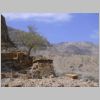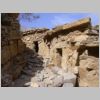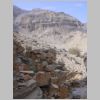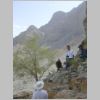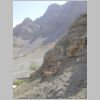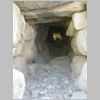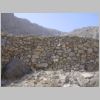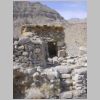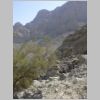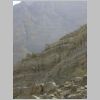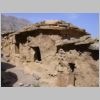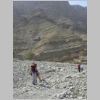ENHG Field Trip to Ras Al Khaimah March 2004
ENHG Field Trip to Ras Al Khaimah March 2004
On the weekend of March 17-19 2004, the Al Ain chapter of the ENHG travelled to Ras al Khaimah for a weekend of touring some of the more spectacular sites in the Emirates.
The tour included stops at:
- the Wadi Suq tombs at Shimal
- the dhow building yards
- the yanz of Wadi Sha'am
- the abandoned village of Sili in Wadi Sha'am
- the ghost town of Jazirat al Hamra
- the fort and farm at Falayah
Yanz of Wadi Sha'am
The yanz of Wadi Sha'am, a collection of 52 storage buildings perched on a narrow mountain ledge overlooking the wadi bed, were unknown to non-locals until a few decades ago when a visiting archaeologist stumbled on the site.
The structures, used by farmers to store grain and fodder, are easily missed at Wadi Sha'am as they blend in so well with the mountainside. Yanz are common in communities in the mountains of the Musandam; visitors will recognize them in many of the remote mountain communities.
Each yanz is built of stone, with little or no mud mortar between the stones. However, the exterior and interior of each is plastered in fine mud. The entire structure is constructed in the same manner as houses and mosques found elsewhere in the Musandam region. That is, the roof is supported by a carefully constructed set of wooden poles laid across the top of the yanz walls. On top of the poles is a woven mesh of palm leaves covered with fine gravel. Stones are used around the edges, with large flat stones overhanging the walls by several centimeters so that rainwater is directed away from the yanz' walls and foundation.
The settlement at Sili in Wadi Sha'am
Across the wade bed and at the end of the wadi is the abandoned settlement at Sili. Evidence suggests individuals were living in the community up until a generation ago -- one man we spoke with estimated people moved out 20 or25 years ago. The exodus from the community would correspond with the construction of new housing, complete with municipal water supply, sewers, schools and electricity, constructed with the first oil revenues.
At least two of the original houses at Sili have been renovated in the past two years, evidence that families are returning to the community, if only for weekends. Many of the doors of the houses are locked and many of the courtyards appear to have been abandoned only recently. Unfortunately a few of the structures are showing signs of neglect.
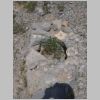 An oven, probably used for baking bread and fish, outside one of the houses Photo by Brien |
 Notice the overhanging flat stones along the roofline and the quality stonework Photo by Brien |
 Most houses, like this one, feature a bench along the front wall of the house Photo by Brien |
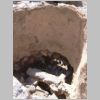 There are three large kilns for firing pottery, this one with a bench on which pottery would have been stacked Photo by Brien |
 Sherds of a failed pot in the soil beside one of the kilns Photo by Brien |
 Many reservoirs, such as this one, are located around the community which is built on three levels Photo by Brien |
 Extensive terraces encircle the stone houses Photo by Brien |
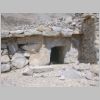 Huge flattened stones are used in this house construction. The passageway to the door is about a meter deep Photo by Brien |
 In the courtyards, flat stones used for preparing food can still be found Photo by Brien |
 Courtyards also feature grinding holes. Often there are two holes, one for grain, the other for spices and medicines Photo by Brien |
 The harsh climate has caused some of the structures to collapse as wooden roof beams deteriorate by climate and infestation Photo by Brien |
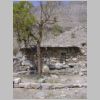 A storage pot rests against a tree in the courtyard of this house Photo by Brien |
 Sun and wind has left the door to this house a bright color against the gray of the stone Photo by Brien |
 Notice the huge stone lintel over the door and the thick stones used along the roofline of this house Photo by Brien |
 Honeycomb scattered on the ground near one house. The condition of the comb confirms people were living here recently Photo by Brien |
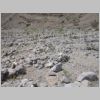 The graveyard at Sili is densely packed with most graves raised above the surface Photo by Brien |
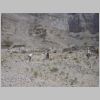 Weary ENHG members make their way back to the vehicles Photo by Brien |

